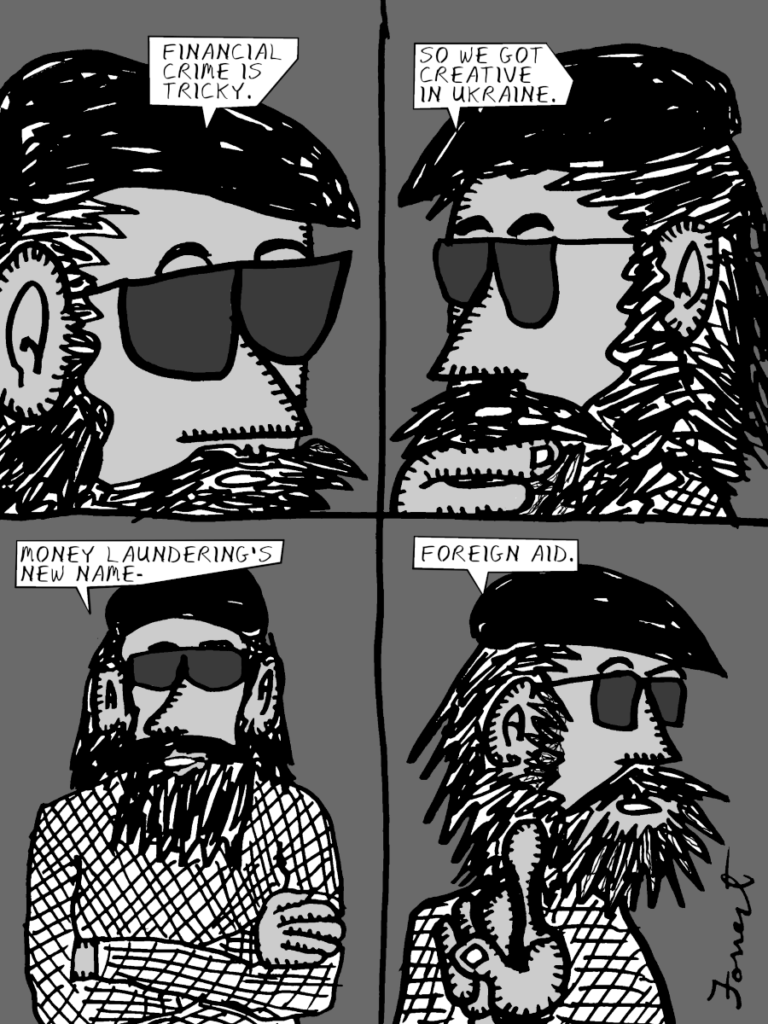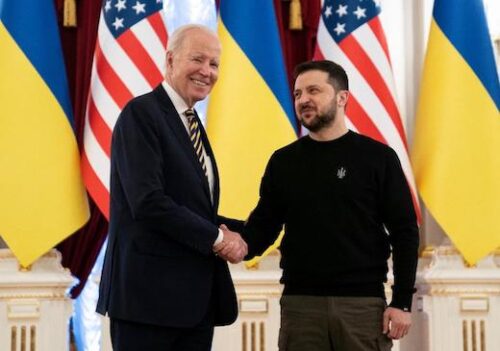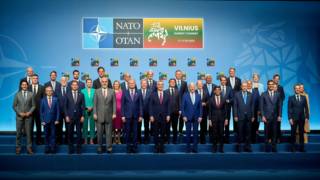I just returned from my third trip to Russia, and my second trip to Donbass (now referring to the republics of Donetsk and Lugansk collectively) in about 8 months. This time, I flew into lovely Tallinn, Estonia and took what should be about a 6-hour bus ride to St. Petersburg. In the end, the bus trip took me about 12 hours due to a long wait in Customs on the Russian side of the border.
Having a US passport and trying to pass the frontier from a hostile, NATO country into Russia during wartime got me immediately flagged for questioning. And then, it turned out I didn’t have all my papers in order as I was still without my journalist credential from the Russian Foreign Ministry which was necessary given that I told the border patrol that I was traveling to do reporting. I was treated very nicely, though the long layover forced me to lose my bus which understandably went on without me.
However, sometimes we find opportunity in seemingly inconvenient detours, and that was true in this case. Thus, I became a witness to a number of Ukrainians, some of them entire families, trying to cross the border and to immigrate to Russia. Indeed, the only other type of passport (besides my US passport) I saw amongst those held over for questioning and processing was the blue Ukranian passport. This is evidence of an inconvenient fact to the Western narrative of the war which portrays Russia as an invader of Ukraine. In fact, many Ukrainians have an affinity for Russia and have voluntarily chosen to live there over the years.
Between 2014 – the real start of the war when the Ukrainian government began attacking its own people in the Donbass – and the beginning of Russia’s intervention in February of 2022, around 1 million Ukrainians had already immigrated to Russia. This was reported in the mainstream press back then, with the BBC writing about these 1 million refugees, and also explaining, “[s]eparatists in the eastern regions of Donetsk and Luhansk declared independence after Russia annexed Crimea from Ukraine. Since the violence erupted, some 2,600 people have been killed and thousands more wounded. The city of Luhansk has been under siege by government forces for the past month and is without proper supplies of food and water.” The number of dead in this war would grow to 14,000 by February of 2022, again before Russia’s Special Military Operations (SMO) had even begun.
Around 1.3 million additional Ukrainians have immigrated to Russia since February of 2022, making Russia the largest recipient of Ukrainian refugees in the world since the beginning of the SMO.
When I commented to one of the Russian border officials, Kirill is his name, about the stack of Ukrainian passports sitting on his desk, he made a point to tell me that they treat the Ukrainians coming in “as human beings.” When my contact in St Petersburg, Boris, was able to send a photo of my newly-acquired press credential to Kirill, I was sent on my way with a handshake and was able to catch the next bus coming through to St. Petersburg almost immediately.
Once in St. Petersburg, I went to Boris’s house for a short rest and then was off by car to Rostov-on-Don, the last Russian city before Donetsk. I was driven in a black Lexus by a kind Russian businessman named Vladimir and along with German, the founder of the humanitarian aid group known as “Leningrad Volunteers.” The car was indeed loaded with humanitarian aid to take to Donbas. After some short introductions, and my dad joke about the “Lexus from Texas,” we were off on our 20-hour journey at a brisk pace of about 110 miles an hour.
We arrived in Rostov in the evening and checked into the Sholokhov Lofts hotel, named after Mikhail Sholokhov, Rostov’s favorite son who wrote the great novel, And Quite Flows the Don. We were told that, up until recently, a portrait of the titular head of the Wagner Group, Yevgeny Prigozhin, had adorned the lobby wall. They took this down after members of the Wagner Group invaded Rostov, putting fear in many of the residents. Now, the hotel only has Hollywood movie posters decorating the walls.
In the early afternoon the next day, my translator Sasha arrived from her hometown of Krasnodar, Russia – a 7-hour train ride from Rostov. Sasha, who is just 22 years old, is a tiny red-headed woman who quickly turned out to be one of the most interesting people I met on my journey. As she explained to me, Sasha has been supporting humanitarian work in Donbass since the age of 12. She told me that she derived her interest in this work from her grandmother who raised her in the “patriotic spirit” of the USSR. As Sasha explained, her parents were too busy working to do much raising of her at all. Sasha, who is from the mainland of Russia, attends the University of Donetsk to live in solidarity with the people who have been under attack there since 2014.
At age 22, Sasha, who wore open-toed sandals even when we traveled to the frontlines, is one of the bravest people I have ever met, and she certainly disabused me of any notion that I was doing anything especially brave by going to the Donbass. But, of course, as Graham Greene once wrote, “with a return ticket, courage becomes an intellectual exercise” anyway.
We quickly set out on our approximately 3-to-4-hour drive to Donetsk City, with a brief stop at a passport control office now run by the Russian Federation subsequent to the September, 2022 referendum in which the people of Donetsk and three other Ukrainian republics voted to join Russia. I was again questioned by officials at this stop, but for only 15 minutes or so. I just resigned myself to the fact that, as an American traveling through Russia at this time, I was not going to go through any border area without some level of questioning. However, the tone of the questioning was always friendly.
We arrived in Donetsk City, a small but lovely town along the Kalmius River, without incident. Our first stop was at the Leningrad Volunteers warehouse to unload some of the aid we had brought and to meet some of the local volunteers. Almost all of these volunteers are life-long residents of Donetsk, and nearly all of them wore military fatigues and have been fighting the Ukrainian forces as part of the Donetsk militia for years, many since the beginning of the conflict in 2014. This is something I cannot impress upon the reader enough. While we are often told that these fighters in the Donbass are Russians or “Russian proxies,” this is simply not true. The lion’s share of these fighters are locals of varying ages, some quite old, who have been fighting for their homes, families and survival since 2014. While there have been Russian and international volunteers who have supported these forces – just as there were international volunteers who went to support the Republicans in Spain in the 1930’s — they are mostly local. Of course, this changed in February of 2022 when Russia began the SMO. But even still, the locals of Donetsk continue to fight on, now alongside the Russian forces.
The lie of “Russian proxies” fighting in the Donbass after 2014 is actually one of the smaller ones of the Western mainstream press, for the claim at least acknowledges that there has been such fighting. Of course, the mainstream media has tried to convince us that there was never such fighting at all and that the Russian SMO beginning in February of 2022 was completely “unprovoked.” This is the big lie that has been peddled in order to gain the consent of the Western populations to militarily support Ukraine. What is also ignored is the fact that this war was escalating greatly before the beginning of the SMO and this escalation indeed provoked it. Thus, according to the Organization for European Security and Cooperation (OESC) — a 57-member organization including many Western countries, including the United States – there were around 2000 cease-fire violations in the Donbass in the weekend just before the SMO began on February 24, 2022. In a rare moment of candor, Reuters reported on February 19, 2022, “Almost 2,000 ceasefire violations were registered in eastern Ukraine by monitors for the Organization for Security and Cooperation in Europe on Saturday, a diplomatic source told Reuters on Sunday. Ukrainian government and separatist forces have been fighting in eastern Ukraine since 2014.”
Jacques Baud, a Swiss intelligence and security consultant and former NATO military analyst, further explains the precipitating events of the SMO:
as early as February 16, Joe Biden knew that the Ukrainians had begun shelling the civilian population of Donbass, putting Vladimir Putin in front of a difficult choice: to help Donbass militarily and create an international problem, or to stand by and watch the Russian-speaking people of Donbass being crushed.
. . . This is what he explained in his speech on February 21.
On that day, he agreed to the request of the Duma and recognized the independence of the two Donbass Republics and, at the same time, he signed friendship and assistance treaties with them.
The Ukrainian artillery bombardment of the Donbass population continued, and, on 23 February, the two Republics asked for military assistance from Russia. On 24 February, Vladimir Putin invoked Article 51 of the United Nations Charter, which provides for mutual military assistance in the framework of a defensive alliance.
In order to make the Russian intervention totally illegal in the eyes of the public we deliberately hid the fact that the war actually started on February 16. The Ukrainian army was preparing to attack the Donbass as early as 2021, as some Russian and European intelligence services were well aware. Jurists will judge.
Of course, none of this was news to the people I met in Donetsk, for they had been living this reality for years. For example, Dimitri, a young resident of Donetsk who has been fighting since 2014 along with his mother and father, told me quite exasperated as he pointed to some of the weapons and ammunition behind him, “what is all this stuff doing here? Why have we been getting this since 2014? Because the war has been going on since then.” Dimitri, who was studying at the university when the conflict began, can no longer fight due to injuries received in the war, including damage to his hearing which is evidenced by the earplugs he wears. He hopes he can go back to his studies.
Just a few days before my arrival in Donetsk, Dimitri’s apartment building was shelled by Ukrainian forces, just as it had been before in 2016. Like many in Donetsk, he is used to quickly repairing the damage and going on with his life.
Dimitri took me to the Donetsk airport and nearby Orthodox church and monastery which were destroyed in fighting between the Ukrainian military and Donetsk militia forces back in 2014-2015. Dimitri participated in the fighting in this area back then, explaining that during that time, this was the area of the most intense fighting in the world. But you would not know this from the mainstream press coverage which has largely ignored this war before February of 2022.
One of the first individuals I interviewed in Donetsk was 36-year-old Vitaly, a big guy with a chubby, boyish face who wore a baseball hat with the red Soviet flag with the hammer and sickle. Vitaly, the father of three children, is from Donetsk and has been fighting there for four years, including in the very tough battle for the steel plant in Mariupol in the summer of 2022. He decided to take up arms after friends of his were killed by Ukrainian forces, including some who were killed by being burned alive by fascist forces –- the same forces, we are told, don’t exist. Vitaly, referring to the mainstream Western media, laughed when saying, “they’ve been saying we’ve been shelling ourselves for 9 years.”
Vitaly has personally fought against soldiers wearing Nazi insignia, and he is very clear that he is fighting fascism. Indeed, when I asked him what the Soviet flag on his hat meant to him, he said that it signified the defeat over Nazism, and he hopes he will contribute to this again. When I asked him about claims that Russia had intervened with soldiers in the war prior to February of 2022 as some allege, he adamantly denied this, as did everyone else I interviewed in Donetsk. However, he has witnessed the fact that Polish and UK soldiers have been fighting with the Ukrainian military since the beginning. Vitaly opined that, given what has transpired over the past 9 years, he does not believe that the Donbass will ever return to Ukraine, and he certainly hopes it will not. Vitaly told me quite stoically that he believes he will not see peace in his lifetime.
During my stay in Donetsk, I twice had dinner with Anastasia, my interpreter during my first trip to the Donbass in November. Anastasia teaches at the University of Donetsk. She has been traveling around Russia, including to the far east, telling of what has been happening in the Donbass since 2014 because many in Russia themselves do not fully understand what has been going on. She told me that when she was recounting her story, she found herself reliving her trauma from 9 years of war and feeling overwhelmed. Anastasia’s parents and 13-year-old brother live near the frontlines in the Donetsk Republic, and she worries greatly about them. Olga is glad that Russia has intervened in the conflict, and she indeed corrected me when I once referred to the Russian SMO as an “invasion,” telling me that Russia did not invade. Rather, they were invited and welcomed in. That does seem to be the prevailing view in Donetsk as far as I can tell.
During my 5-day trip to Donetsk, I was taken to two cities within the conflict zone – Yasinovataya and Gorlovka. I was required to wear body armor and a helmet during this journey, though wearing a seat belt was optional, if not frowned upon. While Donetsk City, which certainly sees its share of shelling, is largely intact and with teeming traffic and a brisk restaurant and café scene, once we got out of the city, this changed pretty quickly. Yasinovataya showed signs of great destruction, and I was told that a lot of this dated back to 2014. The destruction going back that far included a machine factory which is now being used as a base of operations for Donetsk forces and the adjacent administrative building which looks like it could have been an opera house before its being shelled. For its part, the city center of Gorlovka looked largely unmolested with signs of street life and even had an old trolley, clearly from the Soviet era, running through the center of town. But the outskirts of Gorlovka certainly showed signs of war. In both cities, one could hear the sound of shelling in the distance quite frequently.
In Gorlovka, we met with Nikoli, nicknamed “Heavy.” Nikoli looks like a Greek god, standing at probably 6 feet, 5 inches and all muscle. I joked with him while I was standing next to him that I felt like I was appearing next to Ivan Drago in Rocky IV. He got the joke and laughed. While a giant of a man, he seemed very nice and with a strong moral compass. He led us over to a makeshift Orthodox chapel in the cafeteria of what was a school, but which is now the base of operations for his Donetsk militia forces. He told us that, even now after the SMO began, about 90 percent of the forces in Gorlovka are still local Donetsk soldiers, and the other 10 percent are Russian. Again, this is something we rarely get a sense of from the mainstream press.
Nikoli, while sitting in front of the makeshift chapel, explained that while he still considers himself Ukrainian, for after all he was born in Ukraine, he said that Donetsk would never go back to Ukraine because Ukraine had “acted against God” when it began to attack its own people in the Donbass. He made it clear that he was prepared to fight to the end to ensure the survival of the people of Donetsk, and I had no doubt that he was telling the truth about that.
At my request, I met with the First Secretary of the Donetsk section of the Communist Party of the Russian Federation (CPRF), Boris Litvinov. Boris, who has also served in the Donetsk parliament, explained that the Communist Party under his leadership had been one of the leaders and initiators of the 2014 Referendum in which the people of Donetsk voted to become an autonomous republic and leave Ukraine. According to Boris, about 100 members of the Donetsk section of the CPRF are serving on the frontlines of the conflict. Indeed, as Boris explained, the CPRF supports the Russian SMO, only wishing that it had commenced in 2014. Boris is clear that the war in Ukraine is one over the very survival of Russia (regardless of whether it is capitalist or socialist) and that Russia is fighting the collective West which wants to destroy Russia.
Boris compares the fight in the Donbass to the fight of the Republicans against the fascists in Spain in the 1930’s, and he says that there are international fighters from all over the world (Americans, Israelis, Spanish and Colombians, for example) who are fighting alongside the people of Donbass against the fascists just as international fighters helped in Spain.
The last person I interviewed, again at my own request, was Olga Tseselskaya, assistant to the head of the Union of Women of the Republic of Donetsk and First Secretary of the Mothers’ United organization. The Mothers’ United organization, which has 6000 members throughout the Donetsk Republic, advocates for, and provides social services to, the mothers of children killed in the conflict since 2014. I was excited that Olga opened our discussion by saying that she was glad to be talking to someone from Pittsburgh because Pittsburgh and Donetsk City had once been sister cities.
I asked Olga about how she viewed the Russian forces now in Donetsk, and she made it clear that she supported their presence in Donetsk and believed that they were treating the population well. She adamantly denied the claims of mass rape made against the Russians earlier in the conflict. Of course, it should be noted, the Ukrainian parliament’s commissioner for human rights, Lyudmila Denisova, who was the source of these claims was ultimately fired because her claims were found to be unverified and without substantiation, but again the Western media has barely reported on that fact.
When I asked Olga whether she agreed with some Western peace groups, such as the Stop the War Coalition in the UK, that Russia should pull its troops out of the Donbass, she disagreed, saying that she hates to think what would happen to the people of the Donbass if they did. I think that this is something the people of the West need to come to grips with – that the government of Ukraine has done great violence against its own people in the Donbass, and that the people of the Donbass had every right to choose to leave Ukraine and join Russia. If Westerners understood this reality, they would think twice about “standing with” and continuing to arm Ukraine.
 A cathedral near the Donetsk City airport was destroyed in 2014. The airport was also destroyed.
A cathedral near the Donetsk City airport was destroyed in 2014. The airport was also destroyed.
 A bridge near the Donetsk airport which was destroyed in 2015 by Donetsk militia forces to prevent Ukrainian troops and tanks from crossing.
A bridge near the Donetsk airport which was destroyed in 2015 by Donetsk militia forces to prevent Ukrainian troops and tanks from crossing.
• Both photos were taken by Daniel Kovalik.
This post was originally published on Dissident Voice.

















